
Denmark - trams in Denmark
For a full scale picture, please click on the picture shown !
For the tram-trains of Aarhus see the category private rail companies -> Midttrafik
Odense Letbane - tramway of the city of Odense
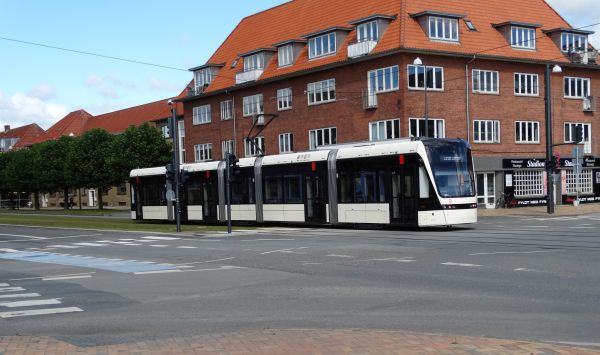
The city of Odense has now a new tramway system (Odense Letbane) which was opened in May 2022. The first line is 7,5 km long
and begins in Tarup, in the north-western part of Odense, and travels via the central railway station, University of Southern Denmark
campus and the new hospital before reaching Hjallese. It has been composed with 1436 mm gauge tracks and uses new Variobahn trams from the Swiss
company Stadler, which have however been built in Germany.
Picture from Bolbro near Odense center 9.7.2022 by Ilkka Siissalo.

A slightly closer look at one of the new Stadler trams.
Picture from Bolbro near Odense center 9.7.2022 by Ilkka Siissalo.
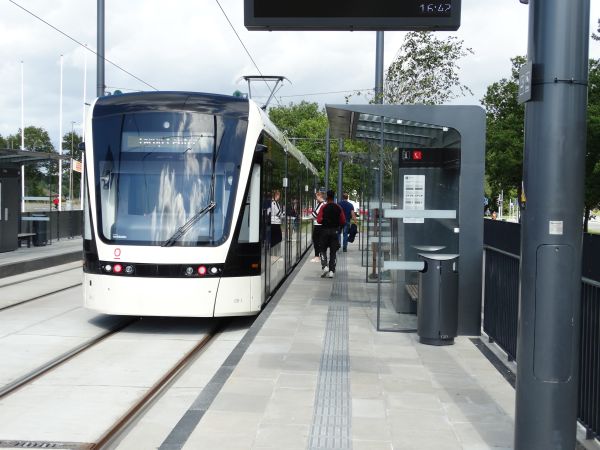
One of the new Stadler trams stopping at the tramstop of Ørbækvej.
Picture from Ørbækvej trmstop 9.7.2022 by Ilkka Siissalo.
Sporvejsmuseet Skjoldenæsholm

The Sporvejsmuseet Skjoldenæsholm is a functioning and large tram museum in Ringsted kommun on the island of Sjælland. There is a large
collection of trams from all over Denmark and also some from other countries such as Switzerland, USA and Sweden.
This old tram no.36 was in the summer of 2024 taking tourists from the parking lot - some half a kilometre away - to the museum area.
This tram was built in 1926 and it was in operation in Flensburg until 1973.
Picture by Ilkka Siissalo 4.7.2024.
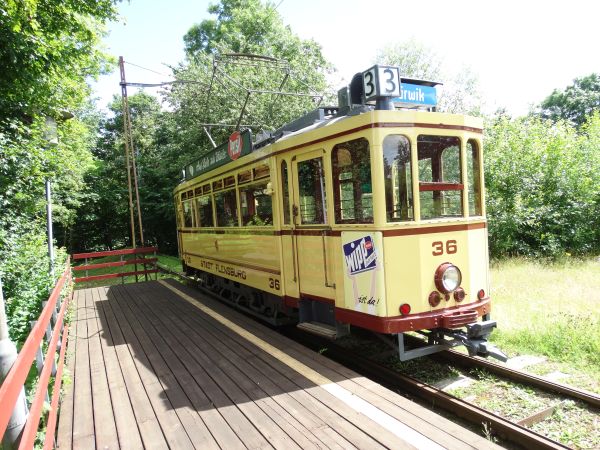
The tram no.36 is a pre-war tram from the German city of Flensburg, not far away from Denmark. Flensburg is in the state of Schleswig-Holstein
which used to be a part of Denmark some 150+ years ago.
Picture by Ilkka Siissalo 4.7.2024.
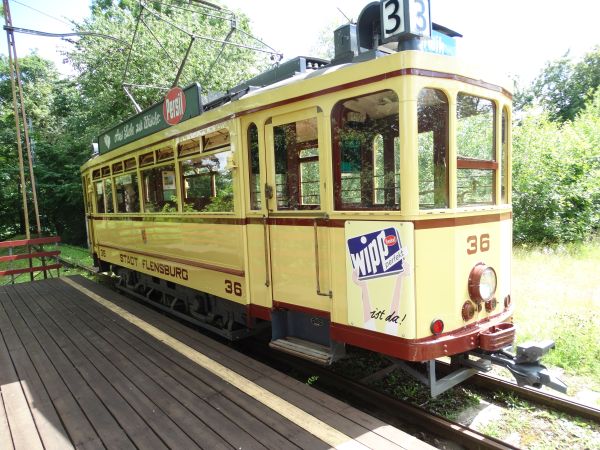
The tram no.36 is a pre-war tram from the German city of Flensburg, not far away from Denmark. Flensburg is in the state of Schleswig-Holstein
which used to be a part of Denmark some 150+ years ago. This tram no.36 was built in 1926 by HAWA with an electric system by Siemens. It has 22
seats and space for 52 standing passengers. It was modified several times and we see it now as it used to be in the 1960s. It was used until
1973 when tram traffic in Flensburg ended.
Picture from Skjoldenæsholm by Ilkka Siissalo 4.7.2024.
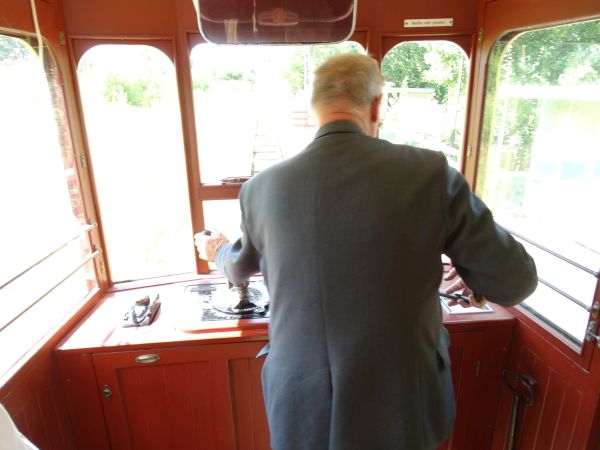
In these 1920s trams the driver had to drive while standing and had to ring a bell with his foot every time the tram was about to leave a
tramstop.
Picture from Skjoldenæsholm by Ilkka Siissalo 4.7.2024.

The museum's metre gauge line is only about half a kilometre long.
Picture from Skjoldenæsholm by Ilkka Siissalo 4.7.2024.
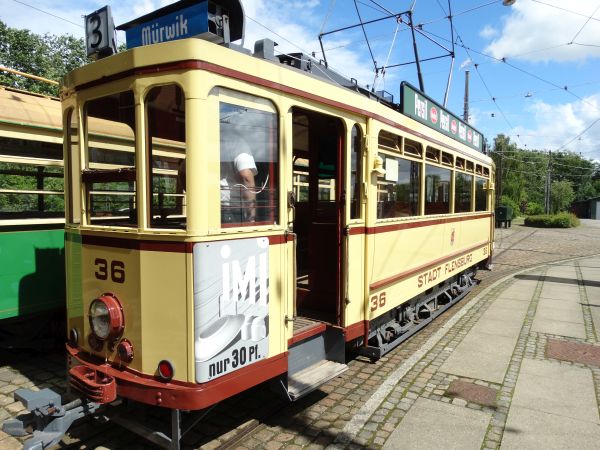
The same tram no. 36 seen from the other direction.
Picture from Skjoldenæsholm by Ilkka Siissalo 4.7.2024.
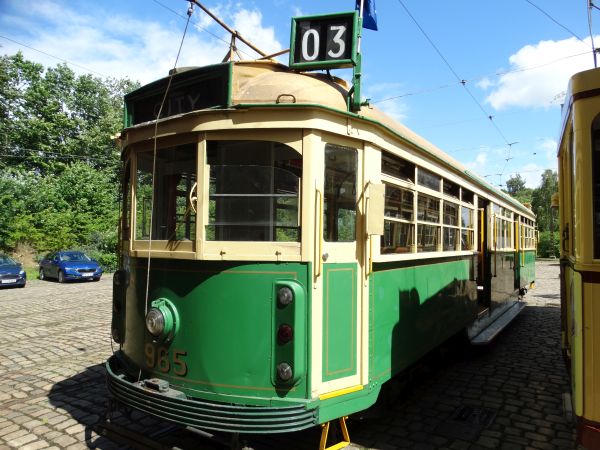
This tram no.965 is from Melbourne Australia and it is from the year 1950. It has 52 seats and enough space for about 100
standing passengers. It came to the museum as a gift in 2006.
Picture from Skjoldenæsholm by Ilkka Siissalo 4.7.2024.
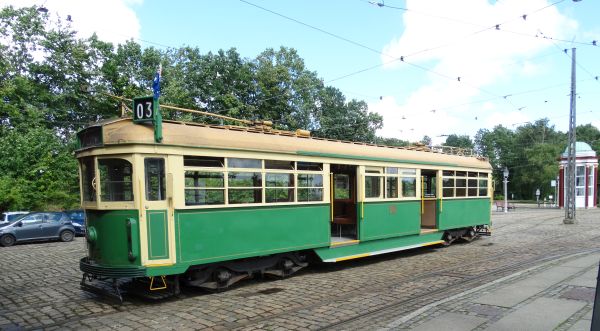
Side view of the Melbourne tram no.985.
Picture from Skjoldenæsholm by Ilkka Siissalo 4.7.2024.
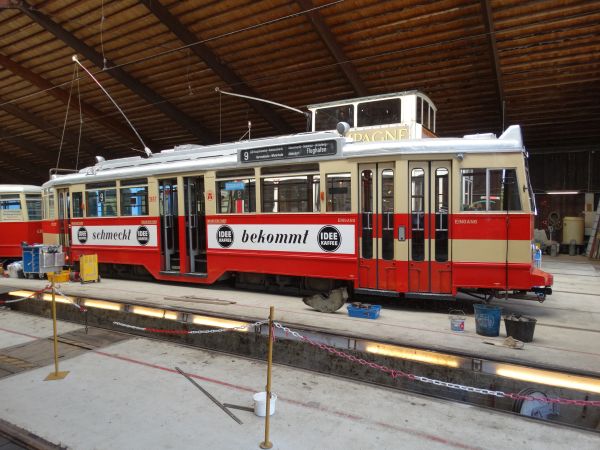
This tram no.3657 is from the city of Hamburg where it used to be the Hamburger Hochbahn tram 3657 from 1952, built by Falkenried.
It has four Siemens motors and 31 seats and 78 places for standing passengers. It was in use in Hamburg until 1978.
Picture from Skjoldenæsholm by Ilkka Siissalo 4.7.2024.
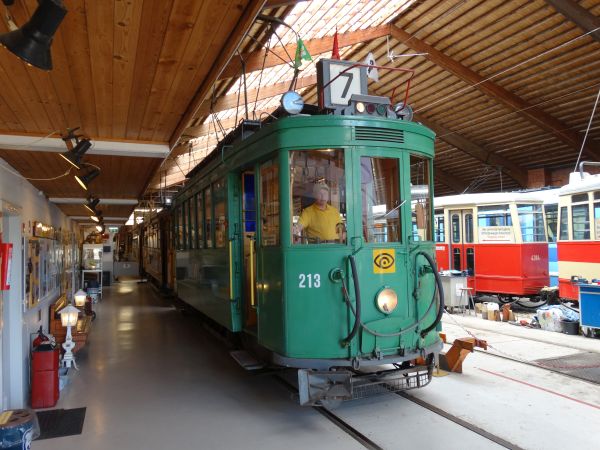
This one is from the city of Basel, Switzerland, tram no.213 of the Basler Verkehrsbetriebe BVB. It's a meter gauge tram built in 1933 by SIG.
It has 20 seats and 44 places for standing passengers. It was in use until 1979.
Picture from Skjoldenæsholm by Ilkka Siissalo 4.7.2024.
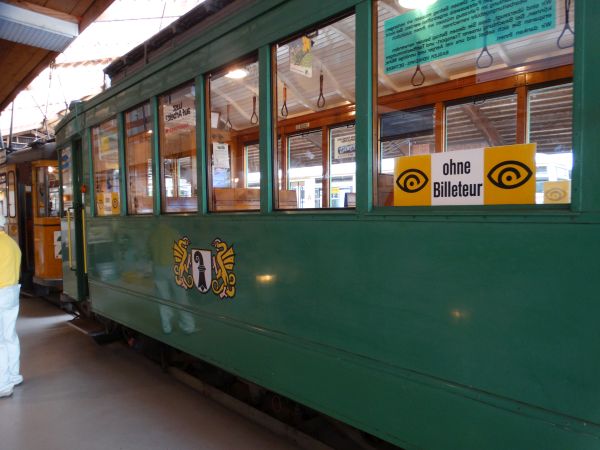
Side view of the same city of Basel tram 213 featuring the logo of BVB with the city of Basel emblem.
Picture from Skjoldenæsholm by Ilkka Siissalo 4.7.2024.
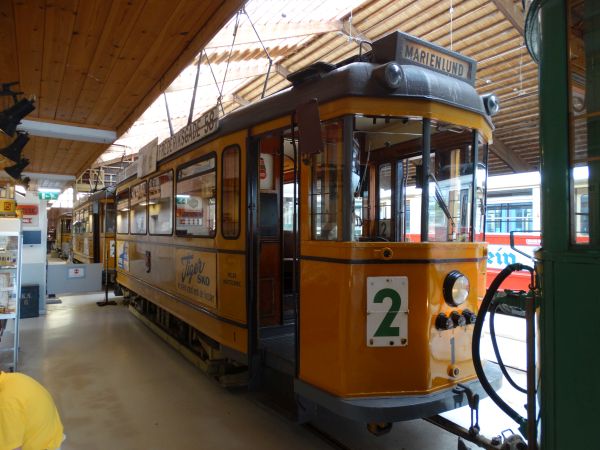
City of Århus (Aarhus) tram no.1 from 1945. It was in use until 1971 and came to the museum in 1973. It has 22 seats and space for 28
standing passengers. It was built by KS, the tramways of København (Copenhagen).
Picture from Skjoldenæsholm by Ilkka Siissalo 4.7.2024.

Almost similar to the one shown above, this Århus tram no.3 was built by Scandia in 1945. It also has 22 seats and 28 standing places.
To be that old, it looks surprisingly modern. It was in use until 1971 and we see it now as it used to look like then.
Picture from Skjoldenæsholm by Ilkka Siissalo 4.7.2024.
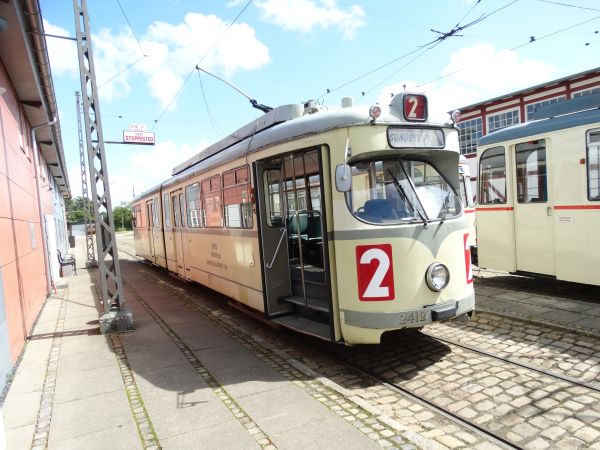
This is again a German tram. It is one of the now already famous Düwag trams, but one of the very early ones. Note that it still uses the
old-fashioned trolley pole to collect electricity. This Düwag is from the year 1957 and we see it now as it used to look like in about 1958.
The tram compaby is Rheinische Bahngesellschaft. This tram runs on 1435mm tracks. It was taken to the museum in 2002.
Picture from Skjoldenæsholm by Ilkka Siissalo 4.7.2024.
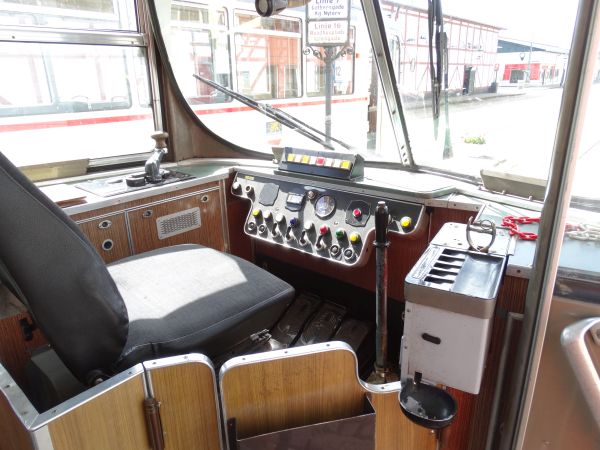
The driver's working space in the same Düwag wagon as shown above. Note especially the modern coin handling apparatus.
Picture from Skjoldenæsholm by Ilkka Siissalo 4.7.2024.
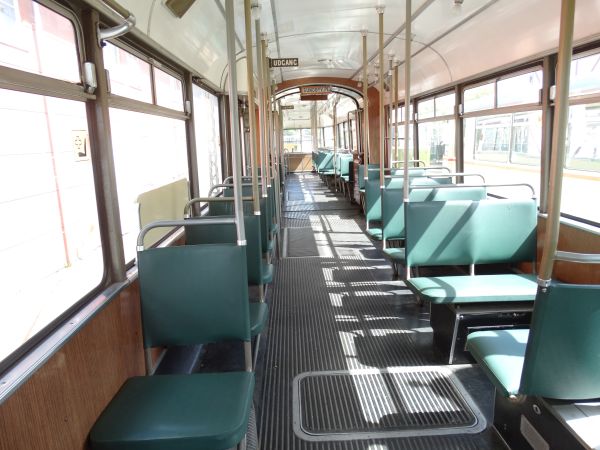
Inside view of the same Düwag wagon as above.
Picture from Skjoldenæsholm by Ilkka Siissalo 4.7.2024.

This one is one of the so called "Mustang" wagons which USA sent as parts of their reparatory aid to various European countries
after World War II under the Marshall aid pact. This one used to be the city of Malmö's Malmö Lokaltrafik no.74. It was built in 1946
by General Motors and it remained in service until 1973. It came to the museum in 1977.
Picture from Skjoldenæsholm by Ilkka Siissalo 4.7.2024.
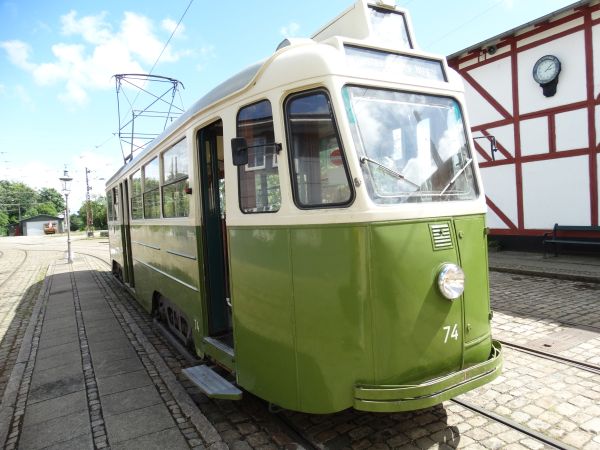
Frontal view of the same Mustang as above.
Picture from Skjoldenæsholm by Ilkka Siissalo 4.7.2024.
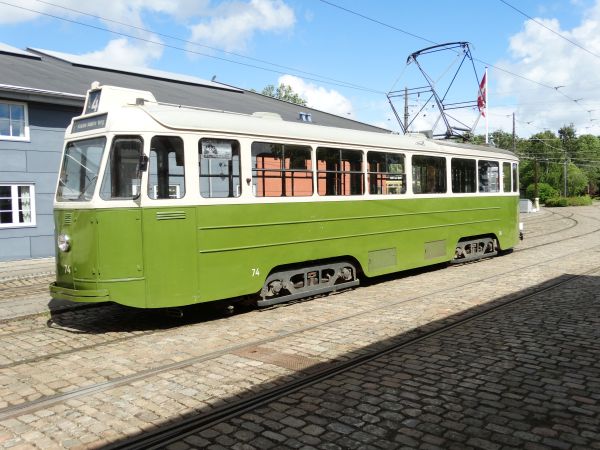
Still the same Malmö Mustang but now seen from the other side.
Picture from Skjoldenæsholm by Ilkka Siissalo 4.7.2024.
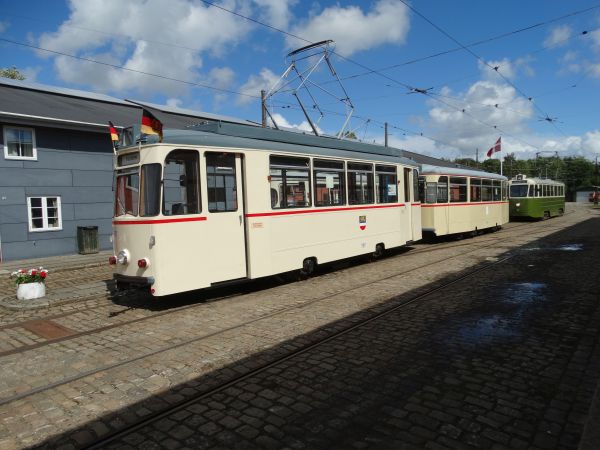
One of the famous East German so called Gotha wagons from the times of the communist East Germany, Deutsche Democratische Republik DDR. This ome was built
by the RAW Schöneweide which today is the servicing point of Berlin's S-Bahn trains but which used to be one of the "people's owned" companies in DDR times.
These Gotha wagons had no bogies, just two fixed axles fairly close to each other, which meant that the wagons moved in quite and unruly manner. This one
belonged to the city of Rostock's Rostocker Strassenbahn AG and it was built in 1976 - although it looks a lot older. It has 22 seats and 53 standing places
and has also a similar unmotorised trailer wagon.
Picture from Skjoldenæsholm by Ilkka Siissalo 4.7.2024.

The same East German Gotha wagon seen more from behind. These small wagons were designed so that they could be run from both ends so that a turning
loop at the end of the line was not necessary. Although the trailer could not be turned around without a loop.
Picture from Skjoldenæsholm by Ilkka Siissalo 4.7.2024.
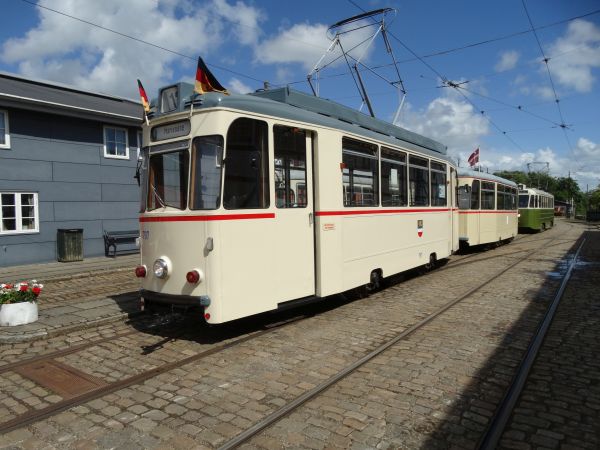
A bit closer look at the same East German Gotha wagon from Rostock. Note that although the wagon is as new as from 1976 the basic design and even the
totally manually operated doors look exactly as if they would be rather from the 1920s.
Picture from Skjoldenæsholm by Ilkka Siissalo 4.7.2024.
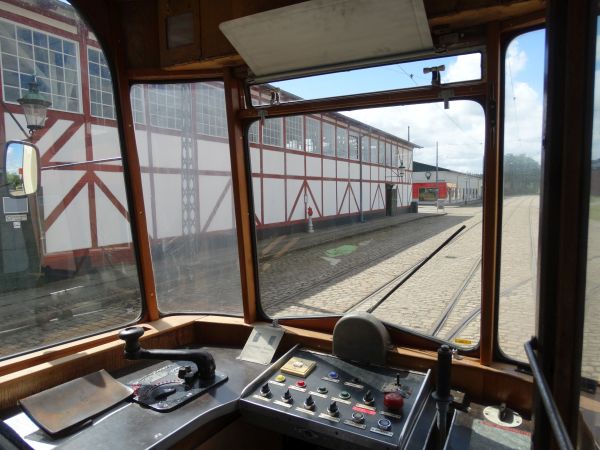
A driver's view out from a Gotha tram.
Picture from Skjoldenæsholm by Ilkka Siissalo 4.7.2024.
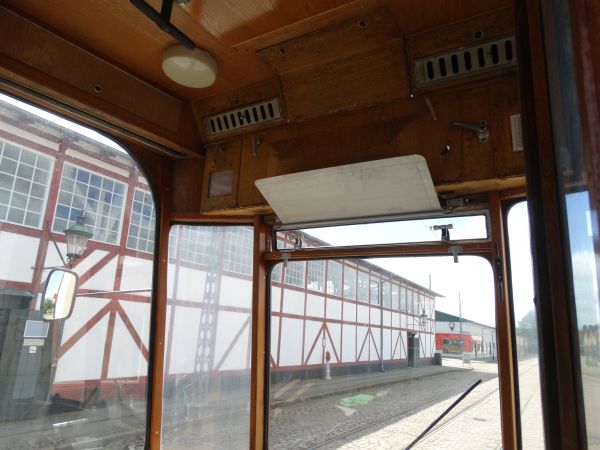
The wooden panels and metal handles above the driver's head look exactly as if they would be from the first generation of Gotha trams from the 1920s and
not from a tram from 1976. But outside the side walls were then in the 1970s already metal and not anymore wood. Not much else had changed in the model
in 50 years.
Picture from Skjoldenæsholm by Ilkka Siissalo 4.7.2024.

In the 1920s the seats of Gotha trams were all wooden. In this 1970s version they were however somewhat softer but still not too modern even by 1970s
standards.
Picture from Skjoldenæsholm by Ilkka Siissalo 4.7.2024.
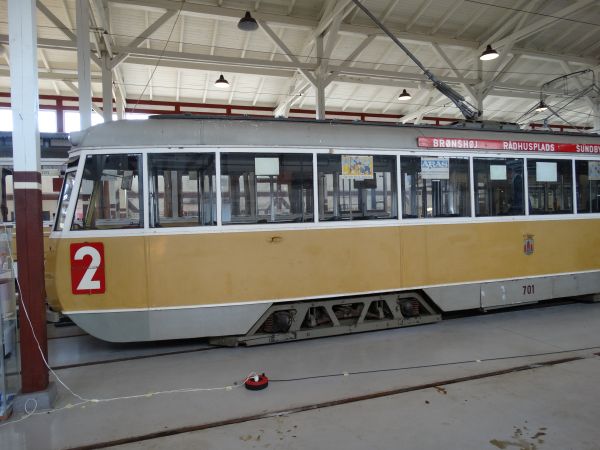
This was the city of Copenhagen's Københavns Sporveje's tram 701 from the year 1949. Compare this with the green Mustang wagon from Malmö shown above.
This one was built by Københavns Sporveje themselves but as far as technology goes it relied heavily on the PCC wagons that USA delivered as part of
their Marshall aid package to Europe. And note how this one looks much like a trailer although it is a motorwagon. This one has 27 seats and 63 standing
passenger places and it was taken out of use in 1967 after a failure of its brakes.
Picture from Skjoldenæsholm by Ilkka Siissalo 4.7.2024.
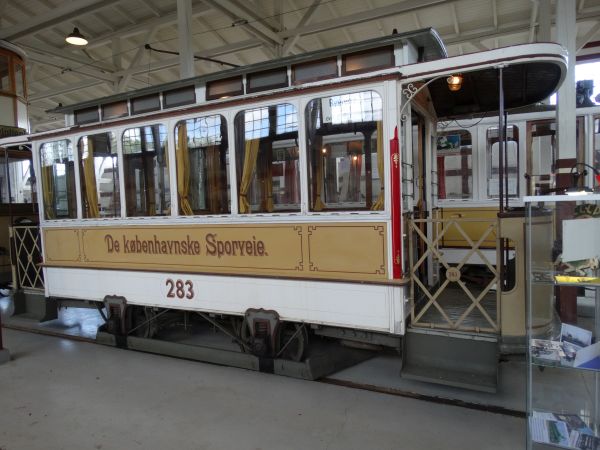
De Københavnske Sporveie's tram trailer wagon 283 was built sometime between 1865-1872. It was originally a horse-pulled tram which then later got a
new chassis in about 1888 and which then in 1902 was rebuilt to a motorless trailer wagon. Under the Københavns Sporveje's time it was numbered as
KS 1046 but now we see it here approximately in the same condition as it used to be around 1910-1920.
Picture from Skjoldenæsholm by Ilkka Siissalo 4.7.2024.
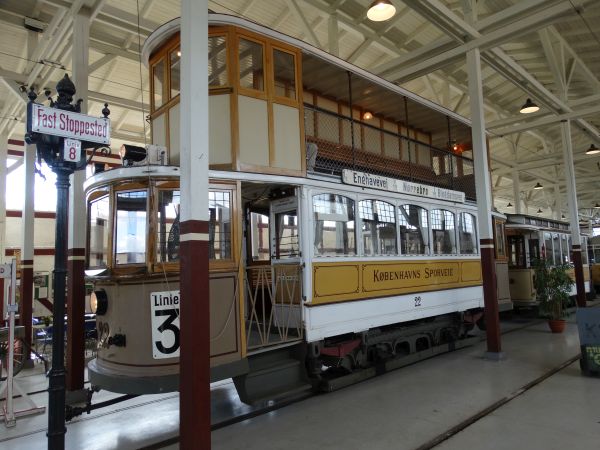
Københavns Sporveje's tram 22 was one of the doubledecker trams nicknamed "Bismarck" after the famous German chancellor and warlord who was then
Denmark's bitterest enemy. People hated these very tall trams since they only had two axles and they were very tall, causing the whole tram to swing back
and forth like a ship at high seas. This one was built in 1900 by F.C.Schultz. It was originally a doubledecker battery driven tram which was in 1902
modified to a normal tram which took its electricity from a catenary wire with a trolley pole. In 1924 it was modified to a single floor tram and
the second floor was removed but now it has been returned into the same shape and look as it used to have in 1915.
Picture from Skjoldenæsholm by Ilkka Siissalo 4.7.2024.
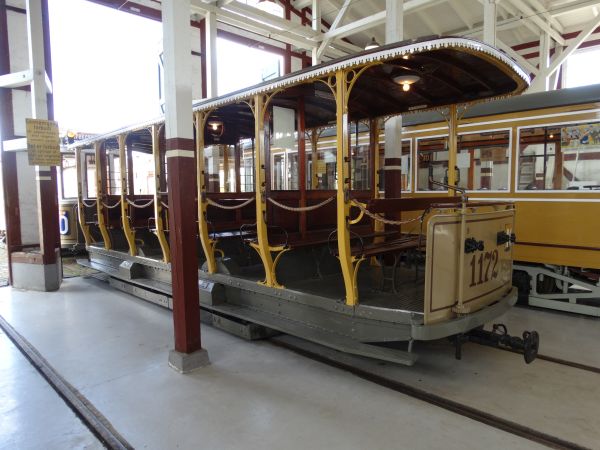
Københavns Sporveje's tram trailer wagon 1172 built by Scandia in 1909. It looks now as it used to look like in 1922-36.
Picture from Skjoldenæsholm by Ilkka Siissalo 4.7.2024.
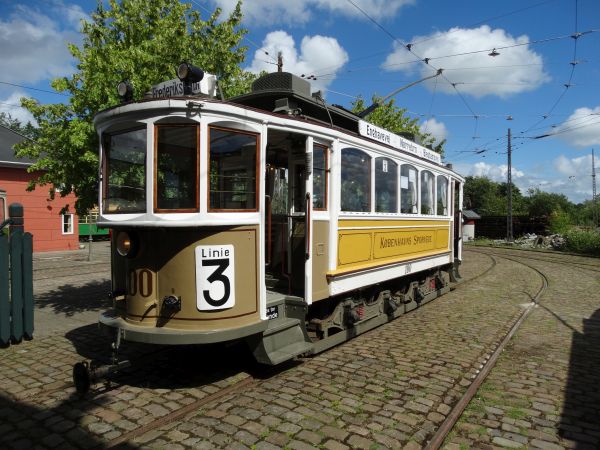
Københavns Sporveje's tram 100 was built by N.Larsens Vognfabrik in 1901 and it remained in use until 1952. It has 20 seats and 35 standing
places. We see it now as it used to be 1924-38.
Picture from Skjoldenæsholm by Ilkka Siissalo 4.7.2024.
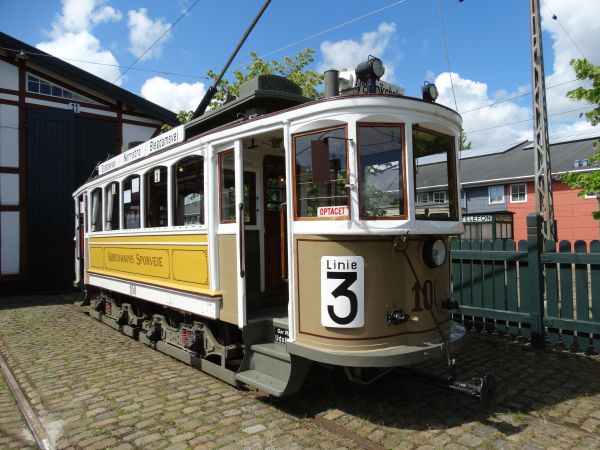
The same Københavns Sporveje's tram 100 seen from the other direction.
Picture from Skjoldenæsholm by Ilkka Siissalo 4.7.2024.
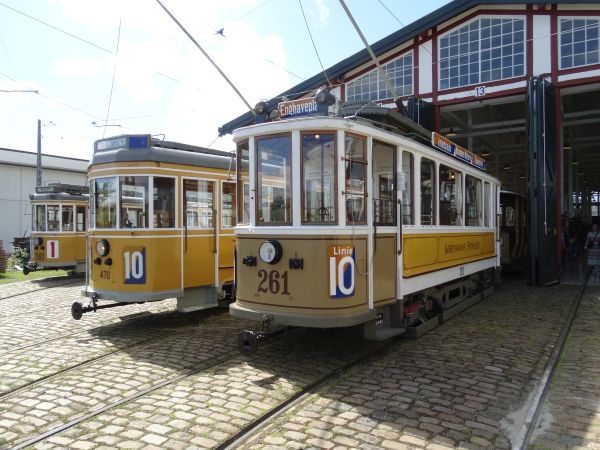
Three oldies in front of their depot. From the left Københavns Sporveje's tram 587 is a two bogies, four axles wagon from 1940, built by KS itself. In the
middle KS 470 is a two axles motorwagon built in 1945 by KS themselves and on the right KS 261 is a two axles tram built by Scandia in 1907.
Picture from Skjoldenæsholm by Ilkka Siissalo 4.7.2024.
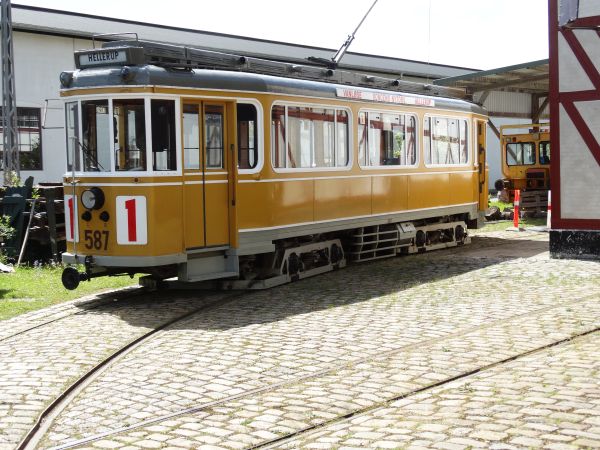
A better look at the bogie wagon KS 587 from 1940. It is 12,3 metres long and has only 20 seats but 60 standing places.
Picture from Skjoldenæsholm by Ilkka Siissalo 4.7.2024.
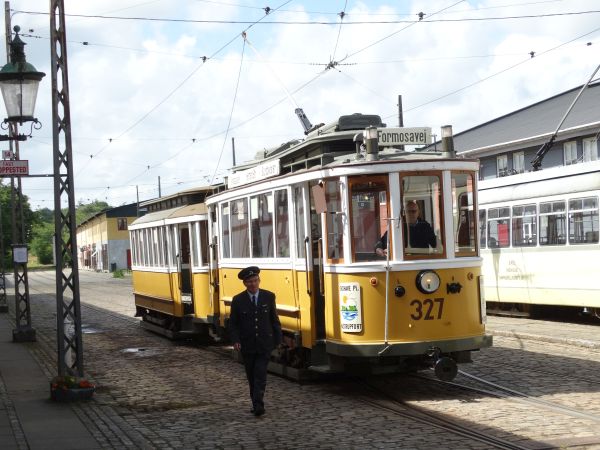
KS 327 is from the year 1912. It was built by Scandia. It has 20 seats and 37 places for standing passengers. It was taken out of use in 1965 and we see
it now as it used to be 1955-65. Note the conductor's matching suit !
Picture from Skjoldenæsholm by Ilkka Siissalo 4.7.2024.
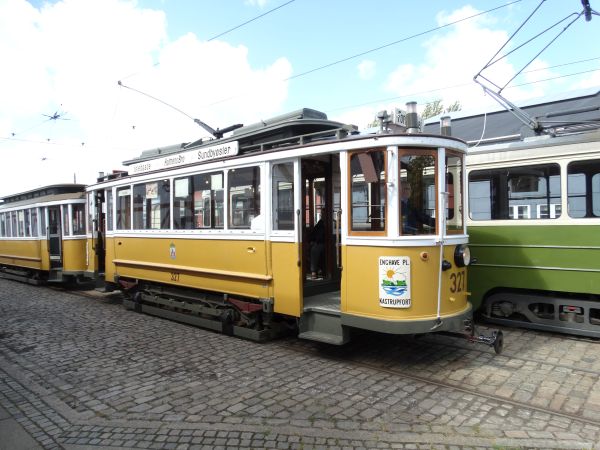
A closer look at the same KS 327.
Picture from Skjoldenæsholm by Ilkka Siissalo 4.7.2024.
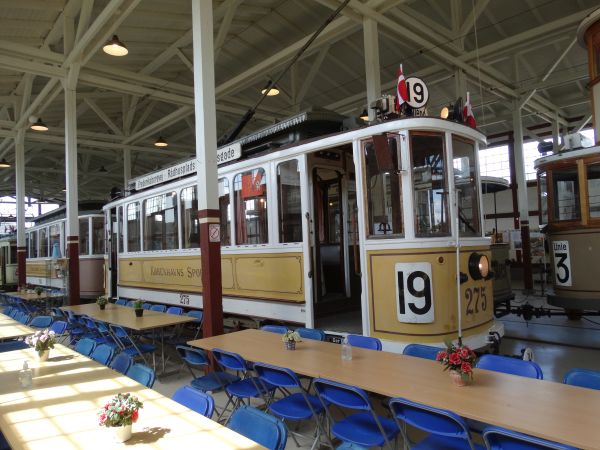
KS 275 is from the year 1907 and it was built by Scandia. It has 20 seats and 31 standing places. We see it now as it used to be during the years 1938-40.
Picture from Skjoldenæsholm by Ilkka Siissalo 4.7.2024.

